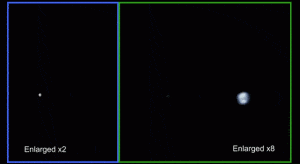
 When NASA’s Juno spacecraft flew past Earth on Oct. 9, 2013, it received a boost in speed of more than 8,800 mph, which set it on course for a July 4, 2016, rendezvous with Jupiter, the largest planet in our solar system. One of Juno’s sensors, a special kind of camera optimized to track faint stars, also had a unique view of the Earth-Moon system. The result was a flyby “movie” showing what our world would look like to a visitor from afar.
When NASA’s Juno spacecraft flew past Earth on Oct. 9, 2013, it received a boost in speed of more than 8,800 mph, which set it on course for a July 4, 2016, rendezvous with Jupiter, the largest planet in our solar system. One of Juno’s sensors, a special kind of camera optimized to track faint stars, also had a unique view of the Earth-Moon system. The result was a flyby “movie” showing what our world would look like to a visitor from afar.
To see video go to www.jpl.nasa.gov/news/news.php?release=2013-360
“If Captain Kirk of the USS Enterprise said, ‘Take us home, Scotty,’ this is what the crew would see,” said Scott Bolton, Juno principal investigator at the Southwest Research Institute, San Antonio. “In our movie, you ride aboard Juno as it approaches Earth and then soars off into the blackness of space. No previous view of our world has ever captured the heavenly waltz of Earth and Moon.”
The Juno-Earth flyby movie is available here:
The musical accompaniment is an original score by Vangelis.
The cameras that took the images for the movie are located near the pointed tip of one of the spacecraft’s three solar-array arms. These cameras look away from the sunlit side of the solar array, so as the spacecraft approached, they were pointed toward Earth. The Earth and Moon came into view when Juno was 600,000 miles away—three times the Earth-Moon separation.
During the flyby, timing was everything. Juno was traveling about twice as fast as a typical satellite, and the spacecraft itself was spinning at 2 rpm. To assemble a movie that wouldn’t make viewers dizzy, the star tracker had to capture a frame each time the camera was facing Earth at exactly the right instant. The frames were sent to Earth, where they were processed into video format.
Also during the flyby, Juno’s Waves instrument, which is tasked with measuring radio and plasma waves in Jupiter’s magnetosphere, recorded amateur radio signals. This was part of a public outreach effort involving ham radio operators from around the world. They were invited to say “HI” to Juno by coordinating radio transmissions that carried the same Morse-coded message. Operators from every continent, including Antarctica, participated. The results can be seen in this video clip: http://photojournal.jpl.nasa.gov/archive/PIA17744.mov
A four-minute video depicting the efforts of a few of the amateur radio operators who participated in the event can be seen at http://youtu.be/_yqHy_MpNiQ
“With the Earth flyby completed, Juno is now on course for arrival at Jupiter on July 4, 2016,” said Rick Nybakken, Juno project manager at JPL.
The Juno spacecraft was launched from Kennedy Space Center in Florida on August 5, 2011. Juno’s launch vehicle was capable of giving the spacecraft only enough energy to reach the asteroid belt, at which point the Sun’s gravity would have pulled it back toward the inner solar system. Mission planners designed the swing by Earth as a gravity assist to increase the spacecraft’s speed enough for it to reach Jupiter.
After Juno arrives and enters orbit around Jupiter in 2016, it will circle the planet 33 times, from pole to pole, and use its collection of science instruments to probe beneath the gas giant’s obscuring cloud cover.
Juno’s name comes from Greek and Roman mythology, in which the god Jupiter drew a veil of clouds around himself to hide his mischief from his wife—but the goddess Juno used her special powers to peer through the clouds and reveal Jupiter’s true nature.


Be the first to comment